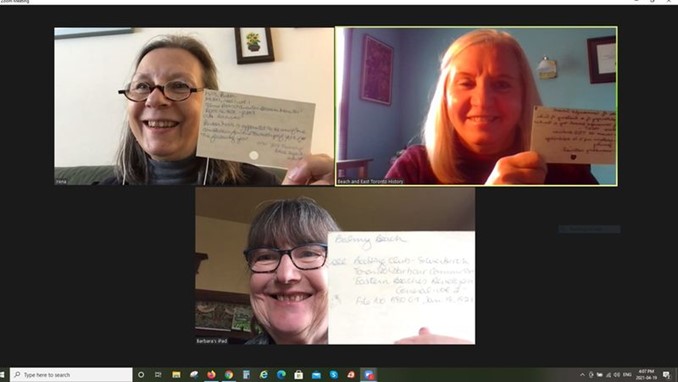Local History Index
Stories from TBETHS Local History IndexNEW East Toronto Gun Club 1907
Early years of the Civic Holiday
Ada Brown Courtice, Founder of Balmy Beach College
Link to The Local History Index
Using the Index
Information in the Local History Index can be located in several ways:
- Browse by scrolling down through the Subjects field. It is sorted alphabetically (first subject only), and then chronologically by date created. Multiple subjects are grouped and separated by double pipes ||.
- Search by pressing "Control F" on the keyboard or using your browser's "Find" or "Find in Page" function. Type your word(s) in the box. Your browser locates and highlights all occurrences of those words. Use the up and down arrows to move to each occurrence.
- Keyword Search. Type a keyword in the search box. A single word will give more results than multiple words.
- Controlled Search. Copy a subject heading from the Subject Headings list and paste the words into the search box. This will give fewer, but more specific results than a keyword search. This will also locate any entries with multiple subjects.
- Save results by copying and pasting each result into a separate document (for example, Excel, Google Sheets, Word, etc.). Be aware that there may be some formatting issues. If the copy/paste function is not working, use the latest version of Chrome.
Questions, suggestions, or need help? Contact Us
Research Sources
About the Index
The Local History Index provides information about people, organizations, places, events, and other subjects related to The Beach and East Toronto Society's catchment area that are documented in a variety of records housed in Toronto's libraries and archives, or available online. Each index entry includes bibliographic information as well as subjects, a description (contents summary), a link to an online record (where available), and the source of the item.
Phase One of the Local History Index, provided here, includes more than 11,300 records. Most of them (91 percent) were created between the 1880s and the 1910s, although the oldest is from 1791 and the newest is from 2021. More than 93 percent of the index entries are to newspapers (47.5 percent) or government records (46 percent). The remaining seven percent are to, in descending order, archival records; books; magazines and journals; theses, dissertations and papers, local history files and scrapbooks; and oral histories.
Development of the Local History Index
The Local History Index was started in the 1980s by the then East Toronto and Beaches Historical Society, who hired university students in 1983, 1984 and 1987 using grant funds from the federal government's Summer Canada employment program. The eleven students researched sources about the Society's catchment area found in Toronto's libraries and archives: City of Toronto Archives, Archives of Ontario, Metropolitan Toronto Library, Ontario Land Registry Office, and the archives of the Roman Catholic Archdiocese of Toronto, Anglican Diocese of Toronto, United Church of Canada, Toronto Harbour Commission, Toronto Board of Education, and Toronto Public Library. Supervised by volunteers Mary Campbell and Barbara Myrvold, the students manually recorded their findings on 3- x 5-inch catalog cards, which were organized alphabetically by subject and filed in a card catalog cabinet housed in the Society's Archives.
The index was the main information source that Mary and Barbara used to prepare two local histories, The Beach in Pictures (1988) and Historical Walking Tour of Kew Beach (1995), published by the Toronto Public Library. Although the Society provided the City of Toronto Archives with a copy of the portion of the local history index relating to East Toronto Council records, but the index, being housed in a private residence, was publicly inaccessible except by telephone or appointment to a small number of researchers.
In March 2019, the directors of The Beach and East Toronto Historical Society (TBETHS, as the organization was renamed in the 1990s) agreed to sponsor a project to increase public access to its index by automating the estimated 13,600 hand-written cards in the Society's Archives and making them available through the Society's website. A project team led by Barbara Myrvold, Irena Lewycka and Katherine Vice (all local residents and professional librarians), spent more than a year preparing for automation, including reviewing 2,250 subject cards and verifying them with standard authorities; developing documents to electronically store the subject authority file and the index entries; creating an electronic form for inputting data; producing an instructional manual for data entry; testing the tools with the Society's directors and making necessary revisions.
In autumn 2020, an excellent response was received to calls from TBETHS and Ward 19 Councillor Brad Bradford for volunteers to transcribe the handwritten index cards into an electronic format. The Project Team trained the volunteers (using Zoom because of the pandemic) and provided them with on-going support. During Phase One, a total of 26 dedicated community volunteers formed the TBETHS Card Index Automation Project Team.
Yvonne Butorac, Mary Campbell, Glenn Chadwick, Ursula Eley, John Ellis, Norm Holman, Aaron Katzsch, Rob Kee, Janice Lavery, Irena Lewycka, Anne Livingston, Deborah Livingston-Lowe, Donna MacLeod, Sam Martin, Ann Menheere, Tom Middleton, Madeline Moscoe, Barbara Myrvold, Sheilah O'Connor, Andrea Orlick, Karen Pederson, Clyde Robinson, Rob Rohr, Molly Saunders, Andra Sheffer, Katherine Vice. |
 TBETHS Card Index Automation Project Leads meet through Zoom, April 2021. Irena Lewycka, Katherine Vice (l to r, top row) and Barbara Myrvold |
Between November 2020 and March 12, 2022, when inputting of data in Phase One was frozen, 15,417 entries had been transcribed and inputted into Google Sheets. Included were all of the index cards in TBETHS Archives (except for pictures, directories and maps), as well as information from a few other sources, notably selections from the bibliographies of the Beach and East Toronto areas that university students had prepared for Toronto Public Library in the 1980s (linked in "Research Sources" above). Using Open Refine, an open-source Java application for refining data, the Project Leads identified and reconciled inconsistent and duplicate data, resulting in the 11,356 lines of edited, "clean" data that was launched on the Society's website in July 2023.
In Phase Two, the Society plans to build an online searchable database to store existing records, add new records, and with an improved interface that enables users to search, order and display the data. Contact Us if you are interested in helping with Phase Two.


